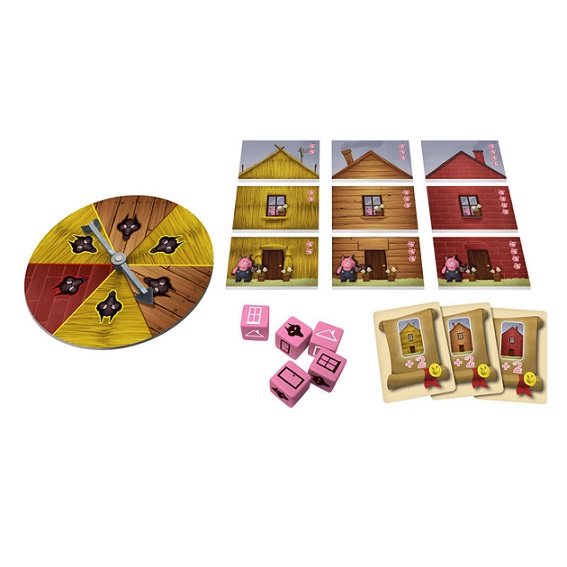The Three Little Pigs: Will The Big Bad Wolf Blow Your House Down?

Take on the role of the pigs in this push your luck dice game inspired by the classic fairy tale.
A family friendly game, The Three Little Pigs was the first entry in IELLO’s Tales and Games series. We’ve played and loved several other members of the series, so how does the first one hold up?
Gameplay
There are nine different stacks — doors, windows, and roofs in three different materials: straw, wood, and bricks. The game ends when a certain number of these stacks (the number varies based on player count) are depleted.
On your turn you take five dice and roll them. You may reroll as many of these dice as you like, two times. Each die can roll a wolf, a door, a roof, or a window. When you roll a wolf you must set it aside and cannot reroll it. If you ever have two wolf symbols, you must immediately stop rolling, cannot buy any house tiles, and must send the wolf after a player. If you roll two matching symbols, you may take a straw tile of the type that matches the symbols (for example, if you roll two roofs you can take a straw roof tile). If you roll three matching symbols you may take either a straw or a wood tile, and if you roll three symbols you may take a straw, wood, or brick tile. You may take two tiles on your turn if you make the correct rolls.
When you take a tile, you add it to one of the houses you are building, or start a new house. A door tile may be added to a house that only has window tiles or used to start a new house, and window tiles may be used to start new houses as well. A house does not need to have both a door and a window. You may add as many window tiles to a house as you wish. Once a roof is placed on top of a house, it is considered complete and you cannot add more tiles to it.
When you send a wolf after someone, you choose a player and choose one of their houses for the wolf to attack. You then huff...and puff....and blow on the spinner. Once the spinner lands on a building material type, all tiles made of that material are removed from the house. If only a roof remains after this happens, it is discarded as well.
Once the game ends, players calculate their score. Uncompleted houses are discarded. You earn points for each tile in your completed houses: two points for straw, three for wood, and four for brick. You earn a point for each completed house, and a bonus point for each flower pot depicted on a tile.

Review
The Three Little Pigs works extremely well as a game for kids and families. Even some adult gaming groups can enjoy it as something fast and extremely light. The rules are simple to learn, with a story everyone knows that blends well with the gameplay. IELLO’s Tales and Games series usually has optional rules to make things a little more complex for adult players and this one is no different. There are variant rules that award additional points for such things as having the most flower pots or being the first to complete a house entirely out of a single material. This adds a new layer to your choices and nicely complements the rules that are already there.
While there are some push-your-luck elements to the game, many of those come in the form of what materials you build with. While rolling two wolves will prevent you from buying new house titles, it allows you to attack another player’s house, rather than actually hurting yours, which is an interesting choice for a dice game and actually allows you to purposefully reroll in an attempt to go after another player.
The take-that elements of the game are nicely implemented all around. The weaker building materials appear more times on the spinner (which again is thematic), but also leaves you with some fun strategic choices as you play the game, particularly when it comes to picking which house to send the wolf after.
This is a game that is slightly more kid focused, and adults who have played a lot of board games will probably know of a similar game they like better. However, it's great way to introduce dice games to people less familiar with board games and it is a game that parents can play with kids and not feel forced to hold back. And you just can’t go wrong with the classic story.
Pros: Thematic, good for families, solid take-that elements that never feel too mean
Cons: Slightly more kid and family focused
Disclosure: we received a complimentary review copy of this game.







